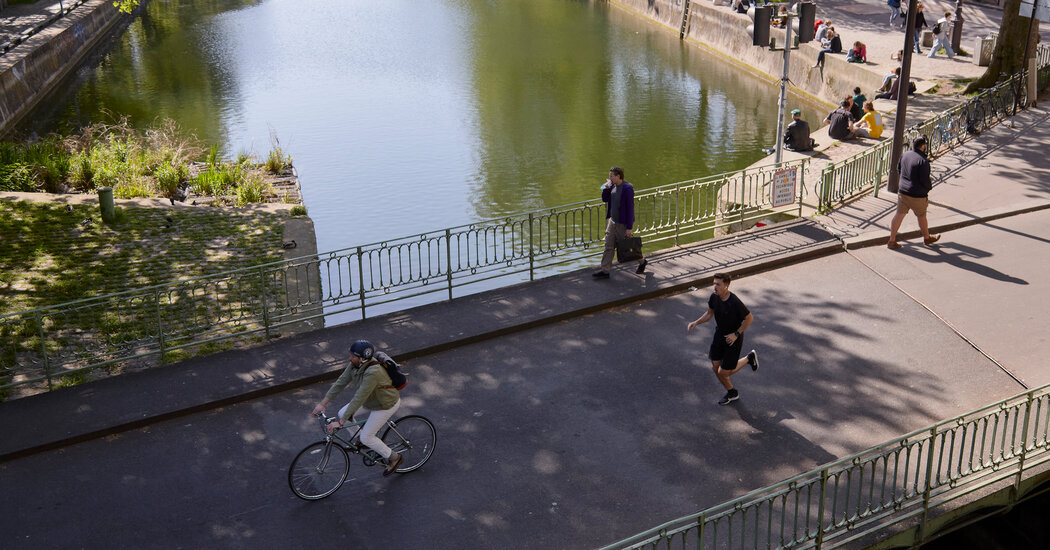The 15-Minute City: Where Urban Planning Meets Conspiracy Theories

Is having all of life’s amenities within a 15-minute walk convenient? Or is it a government leash? We explain.
LONDON — It is an old, seemingly innocuous idea among city planners: The closer you live to your workplace, shops, schools and other amenities, the better your quality of life will be.
But the concept of so-called 15-minute cities, in which life’s necessities are only a short walk or bike ride from home, does not sound utopian to everyone. To some, it sounds like a restriction on the routine act of driving a car. To others, especially on the far right, it sounds like the first step to draconian government lockdowns that will confine people in their homes.
Regardless, it has become a source of widespread confusion, disinformation and conspiracy theories.
A quick history of the 15-minute city.
The idea behind 15-minute cities is not a new one, and is familiar to anyone who has strolled around the historic villages of Europe or remembers bustling Main Streets in the United States before the postwar sprawl that arrived with the Interstate System.
More recently, developments that market themselves as places to live, work and play have helped breathe new life into America’s inner cities. In 2012, Portland, Ore., adopted a plan for “20-minute neighborhoods,” in which residents could live within a half-mile of amenities such as grocery stores, parks and elementary schools.
The concept gained new momentum during the pandemic, which altered both the daily lives of millions of newly cooped-up commuters, as well as ideas about the future of urban design. Proponents say 15-minute cities are healthier for their residents and for the environment, as they encourage walking and discourage a reliance on cars.
Is the idea actually catching on?
So it would seem.
In responding to the challenges posed by the pandemic and climate change, a number of cities around the world have adopted policies inspired by the 15-minute model, aiming to improve their livability and sustainability.
One of the most aggressive efforts has been in Paris, where before the pandemic, the mayor, Anne Hidalgo, effectively declared war on cars in an effort to reduce their planet-warming emissions.
She later made the idea of a 15-minute city a centerpiece of her successful re-election campaign in 2020.
One of her advisers, Carlos Moreno, a French academic, popularized the model of the 15-minute city (or “la ville du quart d’heure”) and outlined three key features during a TED Talk in 2020.
“First, the rhythm of the city should follow humans, not cars,” he said. “Second, each square meter should serve many different purposes. Finally, neighborhoods should be designed so that we can live, work and thrive in them without having to constantly commute elsewhere.”
So why are some people afraid of 15-minute cities?
It’s that first part — a focus on people, rather than cars — that has driven some recent pushback, as 15-minute cities replace Covid lockdowns and mask-wearing as the latest perceived threat to personal freedoms, at least among some people.
Jordan B. Peterson, the psychologist and commentator who is widely critical of the modern left and runs a popular YouTube channel, has warned of “idiot tyrannical bureaucrats” deciding where people can drive and said 15-minute cities “are just another fad hijacked by wannabe authoritarians.”
Last month on Twitter, Mr. Peterson pointed to a report from C40 Cities, a group of 96 cities around the world working to mitigate the effects of climate change, that said “any city where a private vehicle is necessary to get around is likely to be fundamentally unequal.”
The concept of 15-minute cities has also been caught up in broader conspiracy theories about efforts to remake society as the world emerges from the pandemic. The focus of many of those theories is an effort by the World Economic Forum called “The Great Reset.”
That initiative began in 2020, with the help of a cinematic video narrated by the then-Prince of Wales, now King Charles III, who called for “bold and imaginative action” in pursuit of a more equitable and sustainable future.
But the far-reaching, if vague, plan from the group, a nongovernmental organization best known for its annual meeting of business leaders in Davos, Switzerland, soon became fodder for concerns — some more reasonable than others — about an unelected global elite’s using the pandemic to reorder life as we know it.
The Davos group itself later acknowledged in a video that “The Great Reset” branding “hasn’t gone down well” and that it sounded as if it was “masking some nefarious plan for world domination.”
Where the controversy has become real.
The debate over 15-minute cities has been especially pronounced in Britain, where a number of cities, most notably Oxford, have adopted policies that incorporate parts of the idea.
In Parliament last month, Nick Fletcher, a Conservative member who represents part of Yorkshire, in northern England, called for a debate about “the international socialist concept” of 15-minute cities, which, he said, “would take away your personal freedoms.”
Days later, Mark Dolan, a host on GB News, a Fox News-style TV channel that began last year, warned viewers of what he called the “dystopian plan” being pursued by several communities that depends on “a surveillance culture that would make Pyongyang envious.”
In Oxford, a centuries-old university town that has long been bedeviled by traffic congestion, local officials have referred to the 15-minute-city concept as part of their long-term development plans. But the idea has also gotten tangled up in a more immediate dispute over efforts to limit traffic.
A city’s plan leads to confusion, and disinformation.
Officials in Oxford approved a plan last year to install “traffic filters,” which would limit access on six roads in the city during certain times of day. The filters are cameras, not physical barriers, that take photos of vehicles’ license plates. Fines are then issued to those without a permit.
Officials said the system was intended to reduce traffic and move it out to the “ring road” that encircles the city. But it led to widespread confusion about where drivers could go and when, fed by disinformation online that claimed people would be confined to their neighborhoods, which they would need government permission to leave.
In addition to the traffic filters, some areas in Oxford have been designated “low-traffic neighborhoods,” a system used in cities across Britain in which bollards or other barriers prevent vehicular traffic on certain streets, to the dismay of some drivers and residents.
Within weeks, confusion over the traffic filters prompted no fewer than seven different fact-checking efforts (including by The Associated Press and USA Today), as well as a statement from local officials saying that government employees had been subjected to abuse because of “inaccurate information” about the plan.
“These conspiracy theories are causing real-world harm and need to stop,” Liz Leffman, the leader of the Oxfordshire County Council, said in a video. “We have been receiving many calls and emails from worried residents in genuine fear that they might be locked in their own homes. This is categorically untrue.”
Such reassurances have not quelled the controversy, and thousands of protesters in Oxford rallied against the traffic measures last month, the BBC reported.
Professor Moreno, of the Sorbonne, who has been a key promoter of the 15-minute city, addressed the disinformation surrounding the concept in a recent interview with The Times of London.
“People can be totally crazy,” he said. “But I am not affected. I will carry on spreading the message to improve the structure of urban life. This insane campaign of hate won’t win.”
This article has been archived for your research. The original version from The New York Times can be found here.


